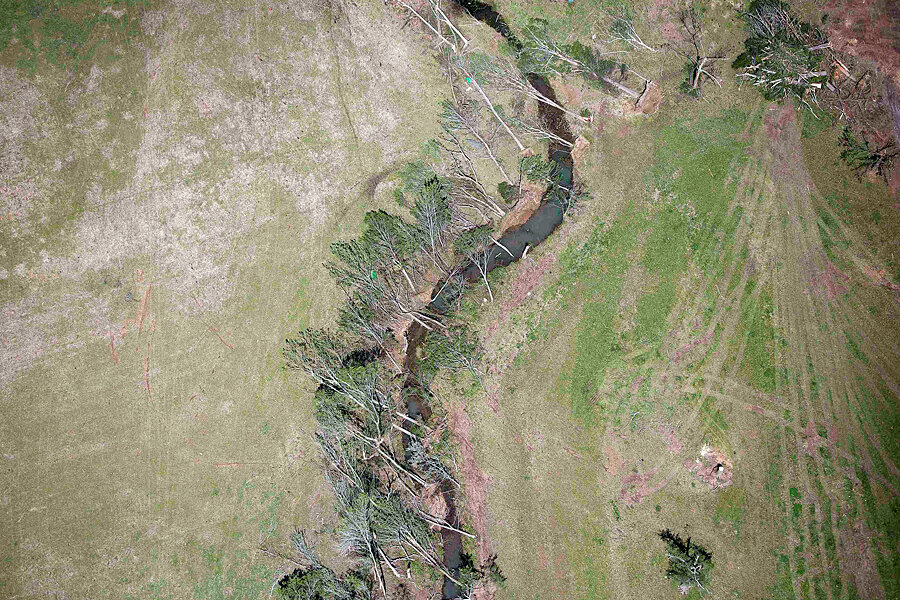Groundbreaking drone coverage of tornado damage piques ire of FAA
Loading...
| Atlanta
As lightning flashed ominously in the distance, video footage, courtesy of a small camera-bearing flying machine, showed the unmistakable footprint of a massive tornado: a vast debris field next to an interstate in Mayflower, Ark.
That footage, taken by storm chaser and photographer Brian Emfinger on Sunday, is now being investigated by federal aviation officials, after a local TV news channel used it as part of its disaster coverage. Mr. Emfinger, a Little Rock-based photojournalist, could be fined $10,000 if the government decides to pursue him for illegal drone-flying.
The Federal Aviation Administration (FAA) insists that such “drone journalism” isn’t legal because it breaks rules against commercial use of unmanned aircraft. Nonetheless, some drone experts say the footage of post-tornado Mayflower heralds “the dawn of the drone journalism age” – a potentially vexing frontier that pits curious citizens against a government with qualms about the spying potential of drones.
“Five years from now, this is going to be commonplace, that people use drones to document news stories, so long as the FAA doesn’t kill that type of activity,” predicts Greg McNeal, a Pepperdine University law professor who blogs about drones and other topics for Forbes. “Right now, [the FAA is] making an expansive claim of government authority to regulate [unmanned aircraft].”
Battered by legal challenges to its drone use policy, the FAA is scrambling to meet a congressional demand to allow some commercial use of drones. The deadline is September 2015 to have a new policy in place.
To be sure, the drones pose privacy problems, are potential safety hazards, and, given the pace of innovation, are likely to become ubiquitous if Washington relaxes air-space rules. The FAA predicts that some 7,500 civilian drones could be active and flying in US airspace within the next few years if rules are relaxed.
The FAA's challenge will be to balance free expression rights of tech-savvy citizens with safety needs. Critics say one problem with the FAA's current policy – that amateurs can fly drones below 400 feet but commercial operators cannot – is that it doesn't seem to address any specific safety concerns.
Either way, the agency has taken a stern view of citizens lofting eyes into the skies for profit, as Emfinger did when he sold the drone video footage to a news outlet. In responses to lawsuits, the FAA has stated that “if you’re using [drones] for any sort of commercial purposes, including journalism, that’s not allowed.”
Last week, Texas EquuSearch, a Houston company that uses drones to search for missing persons around the country, sued the FAA after the agency grounded its fleet because the company hadn't received proper authorization to help with search and rescue efforts.
“We are not aware that any government entity with an existing COA [certificate of authorization] has applied for an emergency naming Texas EquuSearch as its contractor,” the FAA wrote in response.
Meanwhile, the FAA handed cease-and-desist letters last July to the Drone Journalism Lab at the University of Nebraska-Lincoln, and a similar program at the University of Missouri. The Nebraska lab had, among other things, supplied multirotor drone footage for a documentary about a Midwestern drought, without getting authorization to fly, the FAA said.
Citizens using drones to monitor police activity have also raised hackles. Connecticut photographer Pedro Rivera flew a drone over a fatal traffic accident on Feb. 1, and he now alleges in a federal lawsuit that two Hartford, Conn., police officers demanded that his employer punish him for doing so.
According to a police report, the officers who confronted Mr. Rivera “expressed concern that flying a drone over the scene might compromise the integrity of the scene and the ‘privacy of the victim’s body,’ ” the Hartford Courant’s Hilda Munoz reported.
And, notably, a federal administrative judge last month ruled in favor of Raphael Pirker, who had protested a $10,000 FAA fine for flying his Team Black Sheep drones around the University of Virginia to film a promotional video for the college.
One reason the FAA investigation of the Mayflower tornado footage will be closely watched is that many drone journalists interpret the Team Black Sheep ruling in March to mean that FAA rules and fines concerning drones are unenforceable. (The agency has appealed, and its rules remain in force in the meantime.)
As Mr. Emfinger’s video of the Mayflower tornado shows, drones are excellent on-the-scene reporters. Moreover, the quick response – the drone flew minutes after the tornado's winds had subsided – points to search-and-rescue benefits after a disaster.
Media organizations were eager to buy the drone-derived footage. One Arkansas news director told a local newspaper that the drone “gave great perspective of how bad the damage was in Mayflower.”
The broadcasting of drone journalists' work makes it possible for the FAA to take quick action.
Though Mr. Pirker is the only commercial drone pilot to have been fined, FAA officials have taken note of several other recent incidents, including the drone-filming last month of a Harlem building collapse by a citizen-journalist named Brian Wilson. The FAA even told the Washington Nationals baseball club to ground a drone that the club was using during spring training to take publicity pics of players.
At the same time, drone work is becoming commercially ubiquitous, popping up in promotional videos for the state boards of tourism and in Super Bowl commercials – all footage presumably taken illegally, says journalism professor Matt Waite, director of the Drone Journalism Lab, at the University of Nebraska-Lincoln.
“The FAA is in an impossible position here, where their policy is, ‘No one, nowhere, no way, the answer is no,’ [but] they don’t have enough people to enforce this,” says Mr. Waite. “And the longer it takes them to come up with rules that will allow this, the more you’re going to see cases of people using [drones] knowing full well the FAA doesn’t allow it.”








